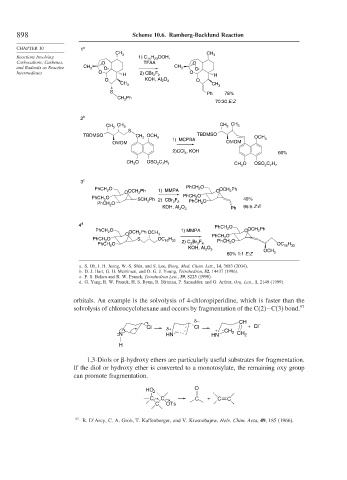Page 922 - Advanced Organic Chemistry Part B - Reactions & Synthesis
P. 922
898 Scheme 10.6. Ramberg-Backlund Reaction
CHAPTER 10 1 a
CH 3 CH 3
Reactions Involving 1) C 11 H OOH,
23
Carbocations, Carbenes, O TFAA O
and Radicals as Reactive CH 3 O CH 3 O
Intermediates O H 2) CBr F O H
2 2
O KOH, Al O 3 O
2
CH 3 CH 3
S Ph 78%
CH Ph
2
70:30 E:Z
2 b
CH CH 3 CH 3 CH 3
3
S
TBDMSO CH 2 OCH TBDMSO
3
1) MCPBA OCH 3
OMOM OMOM
, KOH
2)CCl 4 66%
CH O OSO C H OSO C H
3 2 7 7 CH O 2 7 7
3
3 c
PhCH O PhCH 2 O OCH Ph
2 OCH Ph 1) MMPA O 2
O 2
O PhCH 2 O
PhCH 2 F 49%
SCH 2 Ph 2) CBr 2 2 O
PhCH O PhCH 2
2 95:5 Z:E
KOH, Al O 3 Ph
2
4 d O
O 1) MMPA PhCH 2 O OCH 2 Ph
PhCH 2 OCH Ph OCH
O 2 3 O
O S OC H PhCH 2
PhCH 2 16 33 Br F O
O 2) C 2 2 4 PhCH 2 OC H
PhCH 2 16 33
KOH, Al O 3 OCH
2
60% 1:1 E:Z 3
a. S. Oh, I. H. Jeong, W.-S. Shin, and S. Lee, Biorg. Med. Chem. Lett., 14, 3683 (2004).
b. D. J. Hart, G. H. Merriman, and D. G. J. Young, Tetrahedron, 52, 14437 (1996).
c. P. S. Belica and R. W. Franck, Tetrahedron Lett., 39, 8225 (1998).
d. G. Yang, R. W. Franck, H. S. Byun, R. Bittman, P. Samadder, and G. Arthur, Org. Lett., 1, 2149 (1999).
orbitals. An example is the solvolysis of 4-chloropiperidine, which is faster than the
solvolysis of chlorocyclohexane and occurs by fragmentation of the C(2)−C(3) bond. 97
δ – CH
Cl δ+ Cl + + Cl –
:N HN HN CH 2 CH 2
H
1,3-Diols or -hydroxy ethers are particularly useful substrates for fragmentation.
If the diol or hydroxy ether is converted to a monotosylate, the remaining oxy group
can promote fragmentation.
HO O
C C C + C C
C OTs
97
R. D’Arcy, C. A. Grob, T. Kaffenberger, and V. Krasnobajew, Helv. Chim. Acta, 49, 185 (1966).

